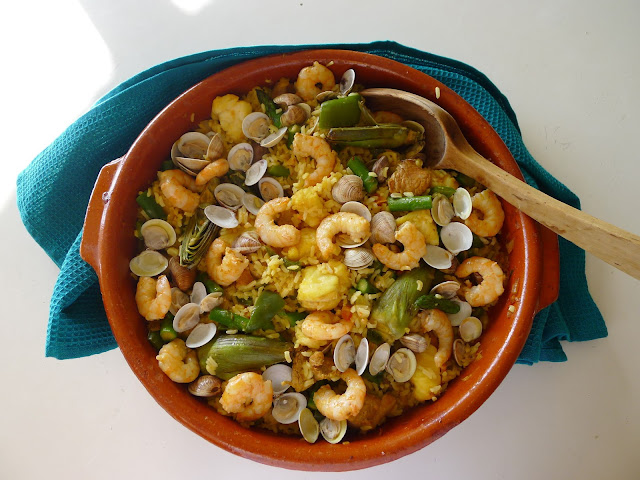 |
| Favorite blog is about cooking in cazuela. |
|
Raise a glass of cava (Spanish bubbly) with me to toast an anniversary—it’s three years since I started this blog, MY KITCHEN IN SPAIN. My first couple of posts were experimental, as I learned how to use the Blogger template and wrestled with uploading photos. My “official” “Welcome to My Kitchen in Spain” blog appeared November 28, 2009.
Finding a voice, choosing subjects that interest first me, then you, the readers; testing and formatting recipes, and, especially, learning to take photos of food all continue to challenge me, engross me every week.
The fun part is doing what I’ve always enjoyed about food writing—cooking and tasting and talking to people about what they eat and how they cook it. I’m a reporter at heart and blogging is a great way to keep a hand in.
After years of writing about Spanish food, I’ve gathered a lot of information and thousands of recipes. Here’s where I can share that knowledge with many more people than those who read my cookbooks or magazine articles.
Traffic to
MY KITCHEN IN SPAIN has grown steadily over three years. Google.com, Google UK, Google Canada, Google Australia and Google España account for far and away most of the referrals. Top links were from Stumbleupon, the
Los Angeles Times after my stories appeared in the food pages of the paper (thanks Russ Parsons), and
LeitesCulinaria.
Where are you, the audience? The US leads readership by a lot, Spain is second. After that it’s other English-speaking countries—UK, Canada and Australia. But, then, Russia. I cannot fathom why I have such wide readership in Russia! Then Germany, France, India and the Philippines.
I am fascinated by the “search keywords” category on the stats page. Here are the all-time most searched: “Spanish cocktails,” “avocado tree,” “grelos” (use “Search” at the upper left of the blog if you want to know what grelos are), “pimentón,” “white watermelon” (yes, I wrote about white watermelon here, but why so many searches?), “cazuela,” “piquillo pepper seeds” and “Spain seafood.”
And now for the top five blog posts: in fifth place,
Bitter Oranges--Mouth-Puckeringly Delicious ; fourth,
This Gazpacho Is Hot; third,
How to Lower Your Cholesterol WithoutMedication, which doesn’t really have much to do with Spanish cooking; second,
Five Star Seafood Soup; and, drum roll, please,
número uno,
Clay Pot Cooking, Cazuela Edition. My welcome page also gets a lot of traffic (link to it by clicking on the photo of me at the left).
I welcome your comments and questions. I'm fascinated to know what you, the readers, want to know about cooking in Spain.
To celebrate this anniversary, here’s another post on clay pot cooking, cazuela edition. Refer to the original post for everything you need to know about cooking in earthenware.
 |
| Rice, pork, seafood and vegetables cooked in a cazuela. |
Cazuela de Arroz a la Malagueña
Rice with Pork and Seafood, Málaga style
It’s a paella if you cook it outdoors in a metal paella pan. It’s
un arroz, merely a rice dish, if you cook it in the kitchen in a cazuela.
If possible buy unshelled shrimp, as the shells and, especially, heads add flavor. Use Spanish round-grain rice for this dish. If not available, Italian arborio is a possible substitute.
Serves 4 to 6.
 |
| Saffron and pimentón flavor the rice. |
½ pound small clams (such as Manila clams)
¾ pound large shrimp in their shells (or ½ pound shelled shrimp)
4 tablespoons olive oil
½ pound pork, cut in cubes
1 small onion, finely chopped
1 green bell pepper, cut in strips
2 cloves garlic, chopped
1 teaspoon sweet pimentón (paprika), not smoked pimentón
1 tomato, peeled and chopped
Pinch of saffron, crushed
Salt and freshly ground black pepper
10 ounces asparagus stalks
1 small artichoke
½ pound monkfish fillets, cut in cubes
4 cups water or stock
2 cups round-grain riceWash the clams in several changes of water. Put them in a pan with ½ cup of water. Cover and cook the clams just until shells open. Remove from heat. Reserve clams. Strain the broth and reserve it.
Shell the shrimp, reserving the shells. You can use the shells to make a stock, along with any fish trimmings. Or else sauté them in hot oil to flavor the oil.
Heat the oil in a 12-inch cazuela. Add the shrimp shells and sauté them until they turn color. The shells flavor the oil. Scoop them out with a skimmer and discard the shells. Now sauté the shrimp in the same oil. Remove them when they are pink and reserve them.
Add the pork to the pan and fry it until browned on all sides. Stir in the onion, green pepper and garlic. Sauté 5 minutes. Stir in the pimentón, then add the tomato. Mix the crushed saffron in ¼ cup hot water. Pour into the cazuela. Add salt (about 2 teaspoons, unless you have heavily salted the stock) and pepper.
Trim ends off asparagus, cut stalks into 1-inch pieces and add to the cazuela. Remove outer leaves from the artichoke and cut it into quarters immediately before adding to the pan. Add the pieces of monkfish.
Combine the reserved clam broth with water or stock to make 4 cups liquid. Add to the cazuela and bring to a boil. Stir in the rice. Bring again to a boil, then reduce heat so liquid bubbles gently until rice is al dente tender, about 18 minutes. Arrange the clams and shrimp on top.
Remove cazuela from heat and allow to set for 5 minutes before serving.

















































